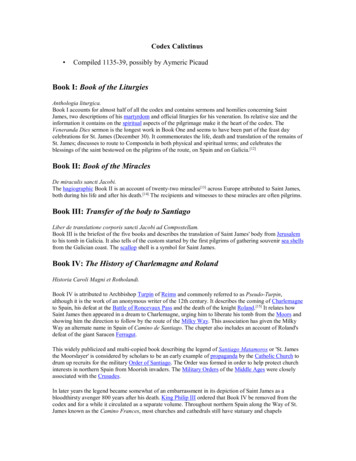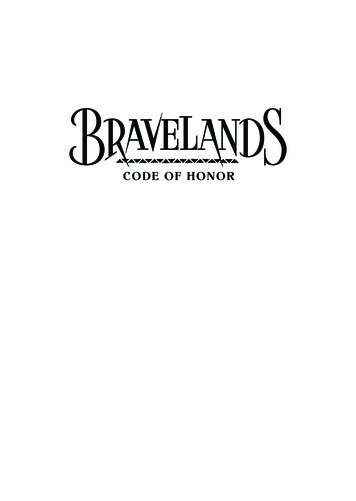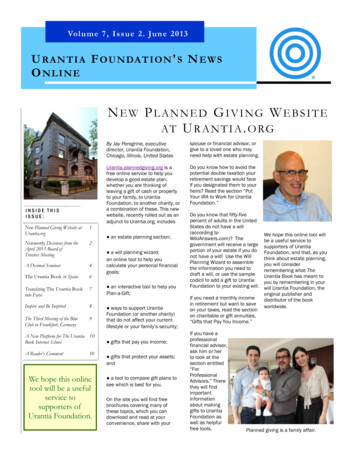
Transcription
Codex Calixtinus Compiled 1135-39, possibly by Aymeric PicaudBook I: Book of the LiturgiesAnthologia liturgica.Book I accounts for almost half of all the codex and contains sermons and homilies concerning SaintJames, two descriptions of his martyrdom and official liturgies for his veneration. Its relative size and theinformation it contains on the spiritual aspects of the pilgrimage make it the heart of the codex. TheVeneranda Dies sermon is the longest work in Book One and seems to have been part of the feast daycelebrations for St. James (December 30). It commemorates the life, death and translation of the remains ofSt. James; discusses to route to Compostela in both physical and spiritual terms; and celebrates theblessings of the saint bestowed on the pilgrims of the route, on Spain and on Galicia.[12]Book II: Book of the MiraclesDe miraculis sancti Jacobi.The hagiographic Book II is an account of twenty-two miracles[13] across Europe attributed to Saint James,both during his life and after his death.[14] The recipients and witnesses to these miracles are often pilgrims.Book III: Transfer of the body to SantiagoLiber de translatione corporis sancti Jacobi ad Compostellam.Book III is the briefest of the five books and describes the translation of Saint James' body from Jerusalemto his tomb in Galicia. It also tells of the custom started by the first pilgrims of gathering souvenir sea shellsfrom the Galician coast. The scallop shell is a symbol for Saint James.Book IV: The History of Charlemagne and RolandHistoria Caroli Magni et Rotholandi.Book IV is attributed to Archbishop Turpin of Reims and commonly referred to as Pseudo-Turpin,although it is the work of an anonymous writer of the 12th century. It describes the coming of Charlemagneto Spain, his defeat at the Battle of Roncevaux Pass and the death of the knight Roland.[15] It relates howSaint James then appeared in a dream to Charlemagne, urging him to liberate his tomb from the Moors andshowing him the direction to follow by the route of the Milky Way. This association has given the MilkyWay an alternate name in Spain of Camino de Santiago. The chapter also includes an account of Roland'sdefeat of the giant Saracen Ferragut.This widely publicized and multi-copied book describing the legend of Santiago Matamoros or 'St. Jamesthe Moorslayer' is considered by scholars to be an early example of propaganda by the Catholic Church todrum up recruits for the military Order of Santiago. The Order was formed in order to help protect churchinterests in northern Spain from Moorish invaders. The Military Orders of the Middle Ages were closelyassociated with the Crusades.In later years the legend became somewhat of an embarrassment in its depiction of Saint James as abloodthirsty avenger 800 years after his death. King Philip III ordered that Book IV be removed from thecodex and for a while it circulated as a separate volume. Throughout northern Spain along the Way of St.James known as the Camino Frances, most churches and cathedrals still have statuary and chapels
applauding 'Saint James the Moorslayer'. Today this legend in northern Spain has cultural and historicalsignificance that is completely separate from any of the original intentions by the Catholic Church.Book V: A Guide for the TravellerIter pro peregrinis ad Compostellam.Book V is a wealth of practical advice for pilgrims,[16] informing them where they should stop, relics theyshould venerate, sanctuaries they should visit, bad food they should be wary of[17] and commercial scams,including in the author's opinion, other churches who claimed to hold relics of St. James.[18] The bookprovides a valuable insight into the life of the 12th-century pilgrim. It also describes the city of Santiago deCompostela and its cathedral. The popular appeal of Book V led to it achieving the greatest fame, and it hasbeen described as the first tourist's guide book.[19] Among Basque scholars, this account is considered ashighly important because it contains some of the earliest Basque words and phrases of the post-Romanperiod.[20]In 1993, UNESCO placed the Spanish section of the pilgrimage on the World Heritage List, describing it as"a testimony to the power of the Christian faith among people of all social classes".[21] The French sectionjoined the list in 1998 when UNESCO declared the cultural and historical importance of the WorldHeritage Sites of the Routes of Santiago de Compostela in France.[22]MusicThree parts of the Codex Calixtinus include music: Book I, Appendix I, and Appendix II. These passagesare of great interest to musicologists as they include early examples of polyphony.[23] The codex containsthe first known composition for three voices, the conductus Congaudeant catholici (Let all Catholicsrejoice together); however, the extreme dissonance encountered when all three voices perform together hasled some scholars to suggest that this was not the original intention.[24] The popularity of the music hascontinued to the present day with modern recordings commercially available.
Chapter I. Roads to Santiago.‘Quatuor viae sunt quae ad sanctum Jacobum tendentes, in unum, ad Pontem Regine , in oris Hispanisecoadunantur.’Four roads meet at Puente la Reina in Spain and become one route to Santiago.One road goes through Saint-Gilles du Gard, Montpellier, Toulouse and the Somport Pass.1The next is through St Mary of Le Puy, Saint Foy of Conques and St Peter of Moissac. 2The third road is via St Mary Magdeline of Vezalay, St Leonard of Limousin and the town of Perigueux.3The last is by St Martin of Tours, St Hilary of Poitiers, St John of Angely, St Eutropius of Saintes and thecity of Bordeaux.4These roads through St Foy, St Leonard and St Martin meet at Ostabat and cross the Pass of Cize.At Puente la Reina they come together with the road over the Somport Pass, and continue as a singleCamino de Santiago.51 The Arles Route through France2 The Le Puy Route through France3 The Vezalay Route through France4 The Paris Route through France5 The Camino Francés through SpainChapter II. The Stages of the Camino.The Aragonese Camino (Somport Pass to Puente la Reina and on to Santiago)The Somport Pass to Puentela Reina has three short stages.The first is from Borce, a village at the foot of the Somport Pass on the Gascon side, to Jaca.The second is Jaca to Monreal, the third from Monreal to Puente la Reina.The Navarrese Camino (Pass of Cize to Puente la Reina and on to Santiago)From the Pass of Cize to Santiago there are thirteen stages.The first short stage is from the village of St Michel at the foot of the Pass of Cize, on the Gascon side, toViscarret.The second is also short, from Viscarret to Pamplona.The third is from the city of Pamplona to Estella.The fourth is Estella to Najera, of course by horse.The fifth, also on horseback, is Najara to the city called Burgos.The sixth is Burgos to Frómista.The seventh is Frómista to Sahagún.The eighth is Sahagún to the city of León.The ninth is León to Rabanal.The tenth is from Rabanal over the pass at Foncebadon to Villafranca del Bierzo, at the mouth of theValcarce.The eleventh is Villafranca to Triacastela, over the pass of Monte Cebrero.The twelfth is Triacastela to Palas de Rey.The thirteenth is a short stage from Palas to SantiagoChapter III. The Towns on the Camino.The Aragonese Camino (Somport Pass to Puente la Reina and on to Santiago)The towns on theCamino de Santiago from the Somport Pass to Puente la Reina are, Borce (at the foot of the mountains onthe Gascon side), then after going over the summit of the mountain, the hostel at Santa Christina; thenCanfranc, then Jaca, then Astorito, then Tiermas, with royal baths of hot water, then Monreal, then Puentela Reina.The Navarrese Camino (Pass of Cize to Puente la Reina and on to Santiago)The most important places on the Camino de Santiago from the Pass of Cize to the basilica inGalacia are, first, the village of Saint-Michel, on the Gascon side at the foot of the Pass of Cize, then, after1
crossing the summit of the mountain, one gets to know the Hospice of Roland, then the village ofRoncesvalles.Next one becomes familiar with Viscarret, then Larrosoana, then the city of Pamplona, thenPuente la Reina, then Estella, full of good bread and the best wine and meat and fish, and plenty of all goodthings. From there is Los Arcos, Logrono, Villarroya, Najera city, St Domingo, Redecilla, Belorado,Vilafranca, Oca forest, Atapuerca, Burgos city, Tardajos, Hornillos del Camino, Castrojeriz, Puente deItero and Fromista, then Carrion, fortunate with bread and wine and meat and all fertility.Next is Sahagun, flowing with delights, with the meadow where the gleaming spears of thevictorious fighters, thrust in to praise God, once bloomed with leaves. Then is Mansilla and León, city ofthe king and court, surrounded by good fortune. Next, is Orbigo, then the city of Astorga, then Rabanel,which is known as ‘The Prisoner’, then the pass of Foncebadon, then Molinaseca, Ponferrada, Cacabelosand Villafranca del Bierza, at the cheek of the valley of Valcarce, then the Saracen Castle, then Villaus, thePass of Monte Cebrero, with its hospice at the summit of the mountain, then Linareas de Rey andTriacastela, at the foot of the Galician mountain, where pilgrims take a stone and carry it with them toCastaneda to make lime for the building of the Apostle’s church.Then is the village of St Michael, Barbadelo, Puertomarin, Sala Regine, Palas de Rey, Leboreiro,Santiago de Boente, Castaneda, Villanova, Ferreiros, and finally Compostella, the most excellent city of theApostle, complete with all delights, having in its care the valuable body of St James, on account of which itis recognised as the luckiest and noblest city in all Spain.I have described these towns and stages so that pilgrims setting out for Santiago, hearing this, canwork out the expenses necessary for their journey.Chapter IV. The Three Hostels of the World.God has set up three supports for the world’s poor: the hostels of Jerusalem, of Mont-Joux and of SantaChrista on the Somport Pass, all placed where they are most needed. They are holy places, houses of Godwhere holy pilgrims can refresh, the destitute can relax, the sick can receive comfort, the dead can beprayed for, and the living given help.Chapter V. People who repaired the road.Here are the names of certain travellers who, in the time of Archbishop Diego of Santiago, and EmperorAlfonso of Spain and Galicia, and of Pope Calixtus, restored the road to Santiago from Rabanel toPortomarin, out of faithful love of God and the Apostle, since the year of Our Lord 1120, in the reign ofAlfonso, King of Aragon, and Louis the Fat, King of the French: Andréas, Rotgerius, Alvitus, Fortus,Arnaldus, Stephanus, and Petrus, who rebuilt the bridge over the Mino destroyed by Queen Urraca.May the souls of these men and their assistants rest in peace.Chapter VI. The Good and Bad Rivers on the Camino.The RiversThese are the rivers on the Camino de Santiago from Puerta de Ciza and from the Somport pass:From Somport flows the healthy water of the River Aragon, which irrigates Spain. From Puerto de Ciza toPamplona pours pure water known as the river Runa. Both the Runa and the river Arga run down to Puentela Reina.The horses die at Rio SaladaAt a place called Lorca, to the east, flows the river known as the Salt Stream.Be careful not to drink it or water your horse there, because the river is lethal. On its banks,as we were going to Santiago, we found two Navarrese sitting there, sharpening their knives, waitingto skin the horses of pilgrims which die after drinking the water.When we asked, they lied and said the water was safe to drink. So we watered our horses,and two died at once, which the men then skinned.Estella to Logrono2
At Estella runs the Ega, with sweet, safe and excellent water. Through the town of Los Arcosflows deadly water. Outside the town near the first hostel, after leaving the village but before coming to thehostel, is a river fatal to both horses and men who drink it.At the town of Torres del Rio in Navarre flows a river deadly to horses and men, and at the villageof Cuevas is a similar death-bringing stream. At Logrono there is a huge river called the Ebro which ishealthy and which abounds in fish.All the rivers between Estella and Logrono are lethal to men and horses, but their fish is approvedto eat.Perils of local foodIn Spain and Galicia, don’t eat the fish called a ‘barbus’, or the one the Poitevins call an‘alosa’ and the Italians ‘clipia’, or any eel, or tench, because without doubt you will immediately dieor fall very sick. If by luck anyone eats and doesn’t get sick, they’re healthier than most or havestayed longer in the country. For all fish, beef and pork in Spain and Galicia make foreigners ill.Good Rivers in Castilla y LeonThe rivers which are sweet and safe to drink are locally named as the following: the Pisuerga,which flows at Puente de Itero; the Carrion; the Cea at Sahagun; the Esla at Mansilla de las Mulas; thePorma, at the big bridge between Mansilla and Leon; the Torio, which flows near Leon below the Jewishquarter; the Bernesga, which flows by the same city, but on the other side, towards Astorga; the Sil atPonferrada in the Green Valley; the Cua that flows by Cacabelos; the Burbia at the bridge at Villafranca;the Valcarce that flows in the Valcarce valley; and the Mino, which flows by Portomarin.Ablutions at LavacollaThere is a river in a wooded place two miles from Santiago called Lavacolla, in which Frenchpilgrims, out of respect for the Apostle, wash not only their private parts but, stripping off their clothes,clean all the dirt from their bodies.Rivers around SantiagoThe river Sar, between Monte de Gozo and Santiago, is healthy, and the river Sarela, which flowsfrom the other side of the city, to the west, is said to be safe.I have described these rivers thus, so that pilgrims setting out for Santiago can learn to avoid thedangerous ones and choose those healthy for themselves and their animals.Chapter VII. The lands and peoples along the Camino de Santiago.Two routesThe Camino de Santiago route along the Toulouse road brings you across the Garonne River intoGascony, then over the Somport Pass into Aragon. From there you come into the province of Navarre,which stretches as far as Puente la Reina and beyond.Another route is over the Pass of Cize; you go from Tours to Poitou, which has the bestcountryside on the Camino. The Poitouians are brave warriors, experts with bows and arrows and spearswho won’t take a backward step in battle. They’re athletic, good looking men who know how to dress well,to speak astutely, and to be generous and hospitable.BordeauxFrom there you come to Saintonge, and on across a stretch of sea and the River Garonne intoBordeaux, famous for having the finest wine and fish in the world, but remember – the local dialect ofFrench is not easy to understand, even more tricky than the version they speak back in Saintonge.At this stage you’ll be tired, but must face into three more days walking across the ‘Landes’ – a desolateregion without supplies of bread, wine, meat, fish, or water, even springs. Villages are rare, although thereis honey, grain and wild boar. If you are crossing it in summer, protect your face from the huge flies thatinfest the place (insects which the locals call ‘guespe’ and ‘tavones’). And unless you watch your step,you’ll sink to your knees in the quicksand that is everywhere.3
GasconyWhen you’ve crossed this place, you come to Gascony, with its white bread and the best andreddest wine, and plenty of forests, streams, meadows and healthy fountains. And the people? Fast-talking,obnoxious, and sex-crazed, they are overfed, poorly-dressed drunks. They’ve two good characteristics: theyare skilled warriors, and they give good hospitality to the poor.They all sit around the fire rather than eating at a table, and drink from one cup. They eat anddrink too much and dress in rags, then, unbelievably, the whole household sprawls out together on a littlerotten straw.Saint-Jean-de-SordeLeaving this country, if you’re on the road to Santiago, you should meet the village of Saint-Jean-de-Sorde.The village is near two rivers, one flowing to the right which the locals call ‘the brook’ and the other on theleft which they call ‘the river’. You cannot cross either without a raft. The boatmen are trouble – bigtrouble. Despite the fact both streams are narrow, they’ll extort money for their services, whether you canafford it or not. If you have a horse, they’ll get angry and forcefully demand four coins. Be careful here.The boat is small, made from a singe tree, not suitable for horses, and you can easily end up in the water.The best option is to take the horse by the bridle and let it swim behind the boat. Whatever you do, don’tget into an overloaded boat, which can suddenly capsize. These boatmen have been known to collect thefares and pile the boat full of pilgrims, so that the boat capsizes and the pilgrims are drowned. Then the evilscoundrels delight in stealing the possessions of the dead.The Basque CountryAround the Pass of Cize is the Basque country, with the city of Bayonne on the north coast. Thelanguage spoken here is incomprehensible. The terrain is woody and mountainous with a serious shortageof bread, wine and other food supplies, except for plenty of apples and cider and milk.This region – near the Cize Pass and the towns of Ostabat and Saint-Jean and Saint-Michel-Piedde-Port – has some truly vicious toll collectors. They come at pilgrims with weapons, and demand anexorbitant fee. If you refuse to pay, they’ll beat you up and take the money, even intrusively frisking you toget it. These people are forest savages. Their hard faces and strange language strike terror into the heart.The rules allow them to charge merchants, and nobody else, but they seize money from pilgrimsand anyone else passing through. Even with the commercial tax, when they’re supposed to charge four orsix coins, they grab double.Those involved in this racket must stop: the toll-gatherers themselves, but also the king of Aragonand other rich men, and their fellow conspirators, namely Raymond de Soule, Vivien d’Aigremont and theVicomte do Saint-Michel, and the boatmen already mentioned and Armand de la Guigne and the otherlords of the rivers, who receive money obtained by the ferrymen. Then there are the priests who knowexactly what’s going on but who still give the Eucharist and confession, and pray for them and welcomethem to church. Until these men publicly make good their crimes and start taking only fair tolls, theyshould be excommunicated in such a way that it’s heard not only in their local churches, but also in thebasilica of Santiago itself, with the pilgrims listening.And if any bishop decides to pardon them, either because he feels it’s his Christian duty orbecause he’s been paid off, he should be kicked out of the church.It needs to be clear that the toll-gatherers cannot take money from pilgrims, and that the ferrymencan charge only one obal to take two men, provided the travellers can afford it. The charge for a horseneeds to be simply one coin, and nothing whatsoever for a poor man. Finally, the boats need to be bigenough to take both men and their horses.Over the PyreneesThe Basque Country has the highest mountain on the Camino. It’s called the Pass of Cize and isboth a gateway to Spain, and a commercial route where important goods are carried from one country toanother.The mountain is eight miles up, and eight miles down the other side, and seems to touch the sky.Climb it and you’ll feel you could push the sky with your hand.The view from the summit takes in the Sea of Brittany, the Atlantic Ocean, and three territories:Castille, Aragon and France.4
The summit is called Charlemagne’s Cross, because here Charlemagne, setting out with his armiesfor Spain, made a track with axes, picks and other digging tools. He first raised a cross and then kneltfacing Galicia and poured out prayers to God and St James.And so it’s traditional for pilgrims to knell here facing St. James’ homeland and to plant their owncrosses. You might find a thousand crosses here, the first station of prayer on the Camino de Santiago.On that mountain, before Spain was Christian, the pagan Navarrese and Basques would not onlyrob pilgrims to Santiago, but mount them like donkeys and then murder them.Near the mountain, to the north, is the valley where it is said Charlemagne was a guest with hisarmy after his soldiers had been killed at Roncevalles. This route is taken by many pilgrims who don’t wantto climb the mountain.Coming down from the summit, you’ll come to the hostel and church with the rock that thegreat hero Roland split with a triple stroke. Next up is the town of Roncevalles, where the battle tookplace in which King Marsile, Roland, Oliver and another 40,000 Christian and Saracen soldiers werekilled.NavarreAfter this valley you come to the province of Navarre, which has plenty of bread, wine, milk andcattle. The Navarrese and the Basques have similar food, clothes and language, although the Basques havea fairer complexion. The Navarrese wear black outfits down as far as their knees, like the Scots. They tieuntreated leather scrips around their feet, leaving bare everything except their soles. They have dark,elbow-length woollen cloaks, fringed like a traveller’s cape, which they call ‘sayas’. Their clothing isvisibly shabby.Navarrese eating and drinking habits are disgusting. The entire family – servant, master, maid,mistress – feed with their hands from one pot in which all the food is mixed together, and swill from onecup, like pigs or dogs. And when they speak, their language sounds so raw, it’s like hearing a dog bark.They call God ‘Urcia’, the Mother of God ‘Andrea Maria’, bread ‘orgui’, wine ‘ardum’, meat‘aragui’, fish ‘araign’, home ‘echea’, the head of household ‘iaona’, the mistress ‘andrea’, church ‘elicera’,priest ‘belaterra’ which means ‘good earth’, corn ‘gari’, water ‘uric’, the king ‘ereguia’, and St James‘Jaona domne Jacue’.These are an undeveloped people, with different customs and characteristics than otherraces. They’re malicious, dark, hostile-looking types, crooked, perverse, treacherous, corrupt anduntrustworthy, obsessed with sex and booze, steeped in violence, wild, savage, condemned andrejected, sour, horrible, and squabbling. They are badness and nastiness personified, utterly lackingin any good qualities. They’re as bad as the Getes and the Saracens, and they despise us French. Ifthey could, a Basque or Navarrese would kill a Frenchman for a cent.In some places, like Vizcaya and Alava, when they get warmed up, the men and women show offtheir private parts to each other. The Navarrese also have sex with their farm animals. And it’s said thatthey put a lock on the backsides of their mules and horses so that nobody except themselves can have atthem. Moreover, they kiss lasciviously the vaginas of women and of mules.Everybody with sense slams the Navarrese. However, they’re good in war, although not soeffective in a siege. They pay their church taxes and present their offerings to the altar; every day aNavarrese goes to church, he makes an offering to God of bread, wine, corn or something else suitable.Wherever a Navarrese or a Basque goes, he has a hunter’s horn around his neck, and carries two orthree spears, which they call ‘auconas’. When he comes to his home he gives a whistle, like a bird. Whenthey’re lying in ambush and want to call companions quietly, they hoot like an owl, or howl like a wolf.Tradition has it that they’re descended from the Scots, because they have such similar customs.It is said that Julius Caesar brought three tribes to conquer the Spaniards who refused topay him taxes: the Nubians, the Scots and men with tails from Cornwall. He ordered them to kill allthe Spanish men, and to keep alive only the women. The invaders came across the sea and, with theirships having been destroyed, devastated the country with sword and fire, from the city of Barcelonaall the way to Saragossa, and from Bayonne to the mountains at Oca. They didn’t get further becausethe Castilians united, defeated them in battle, and drove them back. They fled and settled in themountains at the coast which are between Najera and Pamplona and Bayonne, towards the sea inBiscay and Alava. They built many forts and killed all the local men. Then they raped the womenand had children with them, who afterwards were called Navarrese. This comes from ‘non verus’(not true), because the children didn’t come from a true family.5
As well as that, the Navarrese may first have taken their name from the city of Naddaver inEthiopia, where they originally came from. The apostle and gospel writer Matthew converted their city withhis preaching.BurgosAfter Navarre, the Camino crosses the forest of Oca and continues through the Spanish territory ofCastile and Campos towards Burgos. This country is full of royal treasure, of gold and silver, fabrics andthe strongest horses, and flush with bread, wine, fish, milk and honey. It is however lacking in firewoodand the people are evil and vicious.GaliciaNext is Galicia, which you enter after crossing Leon and the mountains at Irago and Cebrero.Galicia is well-wooded, with rivers, meadows, and orchards, and the deepest clearest springs, but with fewtowns, farmsteads or wheat fields.It is difficult to get wheat-bread and wine. However with plenty of rye bread and cider, livestockand work-horses, milk and honey and enormous seafish, there is little lacking. And there is gold and silver,fabrics and furs from the forests and other riches, as well as Saracen treasure.The Galicians are more like us French people than other Spanish savages, but nevertheless theycan be hot-tempered and litigious.Chapter VIII. Saints’ Tombs to be visited.SAINTS ON THE ARLES ROUTE THROUGH FRANCE:St Trophimus the ConfessorFor those taking the St Giles route to Santiago, the first visit must be to the body of St Trophimusthe Confessor at Arles, mentioned by St Paul in his Letter to Timothy. Paul made him bishop and he wasthe first to be sent to Arles to preach. As Pope Zozimus wrote, from this clearest of springs, the whole ofFrance received rivers of faith. His feast day is the 29th December.St CaesariusNext is the tomb of St Caesarius, bishop and martyr, who in the same city established an order ofnuns. His festival is the 1st November.St HonoratusIn the cemetary at Arles pilgrims seek the help of the bishop St Honoratus, whose feast is the 16thJanuary.St GenesiusThe body of the most holy martyr St Genesius lies in his magnificent and venerated church. NearArles, between two branches of the River Rhone, in the village of Trinquetaille, is an imposing marblecolumn behind the church. There the faithless populace tied St Genesius before cutting his head off; to thisday red bloodstains appear on it. As soon as he was decapitated, he took his head in his own hands andthrew it into the Rhone, then floated his body up the middle of the river to the church of St Honoratus,where he lies in honour. His head, borne by the Rhone and the sea current, was brought by an angel to thecity of Carthage in Spain, where it now rests in glory and works many miracles. His feast day is the 25thAugust.Arles CemetaryNext to be visited is the cemetery called ‘les Alyscamps’, near Arles. Custom decrees that youpray for the dead with prayers, psalms and gifts to charity. The cemetery is a mile long and a mile wide,and there is nothing like it for its numbers of marble tombs. They are carved in different styles, andengraved with Latin letters in an unintelligible, ancient language. The further you look, the more tombs youwill see.In any of the cemetery’s seven churches, if a priest says Mass for the dead, or if a layman has apriest devoutly celebrate, or if a clergyman reads the psalms, he will find, at the final resurrection, helpamong the pious dead to help him achieve salvation in God. For many bodies of martyred saints andconfessors lie there, whose souls rejoice together in the seat of paradise. Their commemoration iscustomarily celebrated on the holiday after the Easter octave.6
St GilesNext, look carefully at the worthy body of St Giles, the holy confessor and abbot. St Giles, famousthroughout the world, should be venerated, celebrated, held dear, invoked, and asked for favours by all.After the prophets and apostles, no saint is more worthy, more holy, more glorious, or quicker to help.More than the other saints, he comes quickly to help the poor and sick and anguished who call him. O whata beautiful and precious thing it is to visit his tomb! Pray to him with all your heart, and that day you willbe happy. I myself have proof of what I say. For I saw a man in this town, who had invoked the saint oneday, escape by the intercession of the blessed confessor from the dilapidated house of a shoemaker namedPeyrot, which collapsed afterwards. Who therefore will see most fully his home? Who will adore God inhis sacred basilica? Who will most embrace his tomb? Who will kiss his venerated altar? Who will tell ofhis most holy life? For a sick man puts on his tunic, and is healed. Through his endless virtue, a man bittenby a snake is healed; another possessed by a demon is liberated; a storm at sea ceases; the daughter ofTheocrite is restored after a long illness; a man sick in his entire body is restored to longed-for wellness; adeer, previously indominitible, is tamed to serve him; an order of monks grows with him as abbot protector;a possessed man is liberated from his demons; a sin of Charlemagne, revealed to him by an angel, isforgiven; a dead man is restored to life, and a violated man to his former health; and more, twocypresswood offerings of the bishops carved with images of the apostles arrive from Rome to a po
Book II: Book of the Miracles De miraculis sancti Jacobi. The . hagiographic. Book II is an account of twenty-two miracles [13] across Europe attributed to Saint James, both during his life and after his death. [14] The recipients and witnesses to these miracles are often pilgrims.











